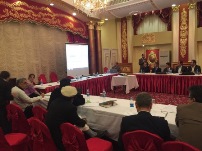 HPRO presented the assessment findings in Kabul6 December 2015 KABUL - The Ministry of Public Health launched the findings of an assessment highlighting the current challenges faced by health facilities in order to improve health care services for all Afghans. The assessment findings were presented in a forum in Kabul attended by over 70 officials from the Ministry of Public Health and NGOs implementing the Basic Package of Health Services (BPHS) as well as UN and donor agencies.
HPRO presented the assessment findings in Kabul6 December 2015 KABUL - The Ministry of Public Health launched the findings of an assessment highlighting the current challenges faced by health facilities in order to improve health care services for all Afghans. The assessment findings were presented in a forum in Kabul attended by over 70 officials from the Ministry of Public Health and NGOs implementing the Basic Package of Health Services (BPHS) as well as UN and donor agencies.
Carried out in all public sector health facilities in 14 insecure provinces, the assessment sought to assess to what extent crucial health services are available and accessible to people while also determining the current condition of medical equipment and supplies in health facilities, availability of human resources and the overall preparedness of health centres to respond to medical emergencies. Supported by WHO, the assessment was conducted by Health Protection and Research Organization (HPRO).
“The Ministry of Public Health will take action to address the weaknesses of the healthcare system identified in this assessment. Our provincial health authorities are currently drafting action plans to fill in the existing gaps in health service provision,” said Dr Ahmad Jan Naeem, Deputy Minister of Public Health of Afghanistan.
The assessment highlights multiple gaps in service provision that must be urgently addressed. Services for nutrition and communicable diseases such as HIV, tuberculosis and malaria are poorly available. Only 52 percent of the assessed facilities provide HIV services. Out of all basic health centres, only 83 percent provide at least half of the required services recommended for maternal, newborn and child health. Necessary medical equipment is available in 81 percent of the health facilities and more than a third of health facilities function in buildings that do not meet quality requirements.
“Crucially, this assessment enables us to update the Health Management Information System database of the Ministry as it discovered that 22 health facilities currently in the system are no longer operating and 38 facilities have been newly established. It is an encouraging finding that only 3 percent of health facilities scored as ‘very low’ in terms of functionality,” said Dr Sayed Ataullah Saeedzai, Director of Evaluation and Health Information System (EHIS).
Recruiting more female health workers is a priority for Afghanistan to ensure effective and equitable health service provision for all Afghans. Around one-fifth of basic health centres, sub health centres and mobile health teams do not currently have any female staff.
“Ensuring we get qualified women to join the health workforce is crucial for improving service delivery and women’s access to healthcare,” said Dr Richard Peeperkorn, WHO Country Representative. “This new assessment points to a number of critical gaps in health service provision in terms of infrastructure, current practices and human resources. WHO remains committed to supporting Afghanistan in implementing the recommendations highlighted by the assessment to ensure better healthcare for all.”
Strengthening the capacity of health facilities to respond to mass casualty incidents and emergencies remains a core focus area for the Ministry of Public Health and WHO. The assessment found that there are currently no health facilities in Logar, Paktika and Uruzgan with the capacity to respond to emergencies and blood transfusion is only available in less than half of all district hospitals and comprehensive health centres.
The assessment was carried out through surveys in 961 health facilities as well as over 1000 exit interviews with people visiting health centres, 14 focus group discussions with communities and dozens of key informant interviews with key health stakeholders.
The study covered 14 provinces categorized by the Ministry of Public Health as being the most insecure provinces with a high number of trauma cases and mass casualty incidents: Farah, Ghazni, Helmand Kandahar, Khost, Kunar, Laghman, Logar, Nangarhar, Nuristan, Paktia, Paktika, Uruzgan and Wardak.
The full assessment report will soon be made publicly available by the Ministry of Public Health and HPRO.


